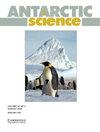南极洲彭萨科拉山脉海王星山脉的无冰山谷:冰川地貌、地质年代学和作为古环境档案的潜力
IF 2
4区 地球科学
Q3 ENVIRONMENTAL SCIENCES
引用次数: 1
摘要
摘要本文描述了南极洲彭萨科拉山脉海王星山脉两个无冰山谷系统的冰川地貌和初始年代学。这些山谷的特点是地貌与以前比现在至少厚200米的更大的冰盖有关。最显著的特征是冰川上的碎片,与现代冰和曲线山脊和土丘分开的离散碎片堆积。该陆地系统与南极和北极其他地方描述的富含碎屑的冷基冰川陆地系统相似,那里的埋藏冰普遍存在。地质年代学数据显示了冰膨胀的多个阶段。最古老的一次发生在公元30ma,覆盖了大部分地貌。随后,在> ~ 2 Ma和> ~1 Ma期间,向山谷的扩张幅度较小。一些局部冰川的扩张发生在< 250 ka。这一冰川阶段序列与彭萨科拉山脉最北端地块(Dufek地块)所描述的相似,表明它代表了上新世-更新世冰盖演化的区域信号。地貌记录及其数百万年的演变使海王星山脉山谷成为一个值得未来研究的地区,我们强调了这方面的潜在途径。本文章由计算机程序翻译,如有差异,请以英文原文为准。
Ice-free valleys in the Neptune Range of the Pensacola Mountains, Antarctica: glacial geomorphology, geochronology and potential as palaeoenvironmental archives
Abstract We describe the glacial geomorphology and initial geochronology of two ice-free valley systems within the Neptune Range of the Pensacola Mountains, Antarctica. These valleys are characterized by landforms associated with formerly more expanded ice sheet(s) that were at least 200 m thicker than at present. The most conspicuous features are areas of supraglacial debris, discrete debris accumulations separated from modern-day ice and curvilinear ridges and mounds. The landsystem bears similarities to debris-rich cold-based glacial landsystems described elsewhere in Antarctica and the Arctic where buried ice is prevalent. Geochronological data demonstrate multiple phases of ice expansion. The oldest, occurring > 3 Ma, overtopped much of the landscape. Subsequent, less expansive advances into the valleys occurred > 2 Ma and > ~1 Ma. An expansion of some local glaciers occurred < 250 ka. This sequence of glacial stages is similar to that described from the northernmost massif of the Pensacola Mountains (Dufek Massif), suggesting that it represents a regional signal of ice-sheet evolution over the Plio-Pleistocene. The geomorphological record and its evolution over millions of years makes the Neptune Range valleys an area worthy of future research and we highlight potential avenues for this.
求助全文
通过发布文献求助,成功后即可免费获取论文全文。
去求助
来源期刊

Antarctic Science
地学-地球科学综合
CiteScore
3.60
自引率
6.20%
发文量
42
审稿时长
3 months
期刊介绍:
Antarctic Science provides a truly international forum for the broad spread of studies that increasingly characterise scientific research in the Antarctic. Whilst emphasising interdisciplinary work, the journal publishes papers from environmental management to biodiversity, from volcanoes to icebergs, and from oceanography to the upper atmosphere. No other journal covers such a wide range of Antarctic scientific studies. The journal attracts papers from all countries currently undertaking Antarctic research. It publishes both review and data papers with no limits on length, two-page short notes on technical developments and recent discoveries, and book reviews. These, together with an editorial discussing broader aspects of science, provide a rich and varied mixture of items to interest researchers in all areas of science. There are no page charges, or charges for colour, to authors publishing in the Journal. One issue each year is normally devoted to a specific theme or papers from a major meeting.
 求助内容:
求助内容: 应助结果提醒方式:
应助结果提醒方式:


